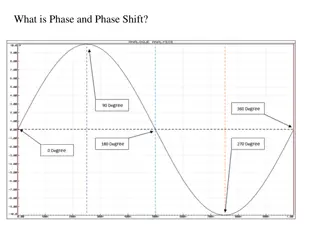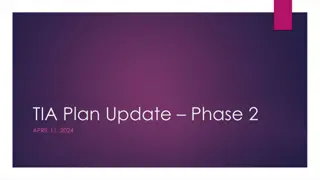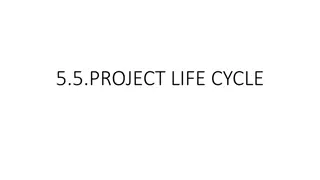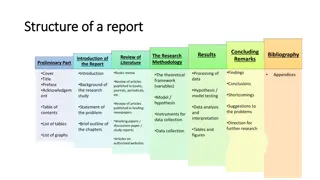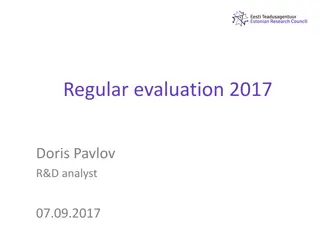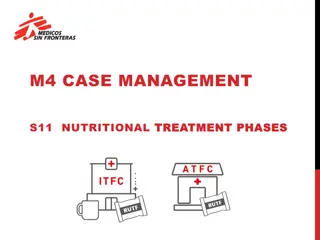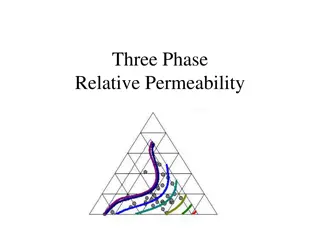Evaluation of PNIN Phase I: Preliminary Results and Research Questions
This article discusses the evaluation of Phase I of the PNIN project, focusing on relevance, coherence, efficacy, impact, and sustainability. It explores the approach, methodology, research questions, and revised Theory of Change. The study aims to assess the performance of PNIN, potential changes needed, and provide recommendations for future implementation. Research questions address relevance, coherence, efficacy, impact, and sustainability of the PNIN approach in addressing malnutrition through optimal policy and programmatic measures.
Uploaded on Sep 16, 2024 | 0 Views
Download Presentation

Please find below an Image/Link to download the presentation.
The content on the website is provided AS IS for your information and personal use only. It may not be sold, licensed, or shared on other websites without obtaining consent from the author. Download presentation by click this link. If you encounter any issues during the download, it is possible that the publisher has removed the file from their server.
E N D
Presentation Transcript
Etude de Contribution PNIN R sultats pr liminaires Juin 2023 Juin 2023
Introduction Objectifs 1. valuer les performances de la PNIN Phase I. 2. Comprendre si des changements sont n cessaires l'approche de la PNIN pour clairer la mise en uvre future. 3. Fournir des recommandations concr tes qui clairent la mise en uvre future. L' tude value (1) la pertinence, (2) la coh rence, (3) l'efficacit , (4) l'impact et (5) la durabilit de la phase 1 de la PNIN la fois au niveau mondial et au sein des pays. Diff renci entre l' valuation de la r alisation des r sultats escompt s (extrants et r sultats directs) et la contribution de la PNIN aux r sultats indirects (impact). n4d.group
Questions de recherche Pertinence : Dans quelle mesure l'approche PNIN est-elle pertinente pour la conduite d'approches politiques et programmatiques optimales pour lutter contre la malnutrition ? Coh rence : Dans quelle mesure le PNIN coordonne et collabore avec les initiatives et les acteurs pertinents pour obtenir des r sultats ? Efficacit : Dans quelle mesure la PNIN atteint-elle ses r sultats (r sultats directs) ? Impact : Dans quelle mesure les activit s de la PNIN mises en uvre au cours de la phase 1 ont-elles contribu l'impact (r sultats indirects) ? Durabilit : Dans quelle mesure les r sultats seront-ils maintenus pour renforcer les capacit s nationales en mati re de politiques et de programmes nutritionnels fond s sur des donn es probantes ? n4d.group
Approche et mthodologie L' valuation value la performance de la phase 1 de la PNIN entre 2016 et 2021 dans tous les pays cibles (r alisation des extrants et des r sultats directs) et sa contribution potentielle aux r sultats indirects. Approche bas e sur la th orie bas e sur un examen de la th orie du changement (ToC) existante de la PNIN pour renforcer le mod le logique de la PNIN. Approche de m thode mixte, collecte de donn es par le biais de documents de programme et conduite de KII avec les parties prenantes dans tous les pays de la PNIN ainsi qu' l' chelle mondiale. Approche d' tudes de cas pour comprendre le niveau d'efficacit et d'impact dans les pays de la PNIN : Pays pour les tudes de cas: Niger, Kenya et Bangladesh L'analyse de la contribution en tant que principale approche d' valuation pour valuer la contribution de la PNIN aux r sultats indirects mis en vidence dans la th orie du changement r vis e. n4d.group
Thorie de Changement rvise n4d.group
Limitations Donn es collect es limit es aux documents du programme partag s avec l' quipe d' valuation. Toutes les parties prenantes prioritaires de tous les pays de la PNIN n taient pas disponibles pour tre interview es. Beaucoup plus d'entretiens ont t organis s pour les pays d' tudes de cas approfondis, les exemples d coulent donc fortement de ces pays. Une analyse compl te de la contribution n cessite une gamme de sources de donn es pour trianguler la contribution aux r sultats indirects. Le manque de donn es disponibles a rendu l'histoire de la contribution difficile assembler. n4d.group
Pertinence Unanimit dans la conceptualisation originale de la PNIN au vu de la demande envers des donn es et des preuves plus nombreuses et de meilleure qualit . La th orie du changement, les conseils techniques et les documents op rationnels ont volu de mani re appropri e depuis 2014. La PNIN est pass e d'une initiative ax e sur les donn es une initiative ax e sur les politiques o l'analyse des donn es vise renforcer et clairer les politiques sur la malnutrition. Suite la pression du MTR et de l'UE pour que le NIPN si ge sous C4N au sein de la GIZ/BMZ, la PNIN est mieux soutenue et quip e pour atteindre ses objectifs. La configuration op rationnelle et la conception de la PNIN en font une initiative complexe; difficile pour les rapports centralis s et les documents op rationnels de saisir pleinement l' ventail de la mise en uvre des pays, les niveaux de performance et de communiquer les r sultats. Les dispositions institutionnelles sont une condition pr alable l'appropriation nationale, l'engagement multisectoriel et la g n ration de preuves pertinentes pour les politiques. La PNIN d montre la pertinence des politiques et des programmes, bien qu'il soit trop t t pour mesurer les impacts tangibles. La PNIN a montr qu'elle tait capable de r pondre aux besoins des pays, tels que la cartographie des programmes et des indicateurs de convergence, et le suivi des liens. Dans certains pays, int r t croissant pour la PNIN soutenant le d veloppement du suivi du financement de la nutrition. La PNIN n'est pas int gr e l' cosyst me mondial pour tre en mesure de r pondre aux priorit s et aux besoins li s aux politiques et aux programmes identifi s l' chelle mondiale n4d.group
Cohrence In early stages, NIPN shared lessons and communicated its approach and outcomes at the global and regional level and more recently the focus has been at the Global Gatherings. The lack of more strategic engagement between NIPN and SUN at the global level and via the newly formed regional hubs is surprising. Opportunities exist to form more strategic alliances between the two initiatives. The institutional set up of NIPN has been vital to the engagement with allied sectors. Countries vary enormously in degree of engagement and collaboration with other country actors and there is recognition across all countries that improving communication with other actors is a priority for Phase 2. Communication and visibility plans should help to ensure synergies are being harnessed. However, adherence to plans has been inconsistent and opportunities for better engagement with other initiatives and actors has not always been realised. There are gaps in engagement within NIPN countries including humanitarian data, the EC-NIS initiative and other data systems including HIS. n4d.group
Effectiveness Countries feel well supported by C4N (Brussels and Technical Consultants) in terms of guidance, peer interactions and facilitating at the inception of NIPN. NIPNs integration into government information systems and structures is essential for its effectiveness and created a strong sense of national ownership in several countries laying the foundations for longer-term sustainability. The policy question formulation process undertaken in all countries in Phase 1 has progressed well although some countries have achieved more than others. The policy cycle analysis has strengthened partnerships between NIPN and numerous stakeholders. The NIPN data dashboards/repositories were all developed in Phase 1, but the extent of their use and updating varies extensively. There is no systematic monitoring of dashboard uptake/use Policy outputs have been produced in all countries but most have not been able to determine utility through evaluation or uptake. n4d.group
Effectiveness Capacity strengthening is a focus for all NIPNs and is an appropriate approach to support localisation and government ownership. It has had a substantial impact on increasing understanding of the role of nutrition in sector programmes and monitoring systems for implementation in some countries. The focus of capacity building has been at the national level, but this now needs to scale to the sub-national level to be even more effective. Staff turnover within national governments is a clear barrier to sustained capacity strengthening. The complexity of sub-national roll out should not be underestimated as the success of devolved NIPN will depend on the resources, capacities and institutional arrangements which vary enormously. n4d.group
Impact In some countries, NIPN has informed and is now playing a key role in monitoring national nutrition action plans and nutrition sensitive sector programming. Extensive work has/is happening in several countries on sector indicators both to align with multi- sectoral plans. NIPN is also strengthening country ability to track nutrition progress through re-analysis of survey data and through sector surveys. Critical barriers that prohibit NIPN s ability to strengthen countries ability to track nutrition progress include lack of quality data available and inability to coordinate across ministries. The policy outputs (briefing and technical notes) are beginning to inform multi-sector and sectoral plans and priorities. The NIPN dashboards are widely seen as a vital tool that provide a 'one-stop shop' for policymakers and a potential data repository for researchers and others. n4d.group
Impact There is recognition across all countries that NIPN needs longer to inform and influence multisectoral policymaking and investments on nutrition, particularly given the delay in establishing NIPN in Phase 1 and during the transition to Phase 2. There is a widely-held belief that in some countries NIPN has created the enabling environment for strengthened evidence-based decision making and that in Phase 2 and beyond, NIPN outputs will directly influence and support policy development at sector and multi-sector level. n4d.group
Sustainability Limited focus on sustainability in Phase 1 as countries were establishing the platforms. Phase 2, sustainability has been a priority. Sustainability plans for each country are at varying stages. Technical Capacity strengthening activities have contributed substantially to technical sustainability. Promising examples of technical sustainability have utilized relationships with local researchers and institutions to build capacities. Turnover within government a risk. Financial The arrangements of NIPN in Phase 1 saw government partners were directly financed via the EUDs as an approach to foster greater government ownership and systems strengthening. Phase 2 arrangements have changed with funding going through GIZ, UNICEF, CARTIE Stakeholders in several countries believe external support will be needed for the gains of NIPN to be continued. Particularly true for the NIPNs which experienced significant delays during the inception and transition phases. Some countries are developing risk mitigation strategies. n4d.group
Sustainability Institutional Phase 1 activities have enabled a strong sense of institutional ownership in several countries- the unfortunate experience of Bangladesh highlights the critical importance of national institutional ownership for the NIPN to be sustainable. The effectiveness of multi-sectoral coordination and collaboration is critical to institutional sustainability. Some countries have been more successful than others at this. Scaling NIPN to be relevant at the sub-national level is an important strategic aim for institutional sustainability. n4d.group
Sustainability NIPN is having an impact through strengthening technical knowledge amongst sectors staff, enhancing multi- sectoral nutrition data systems, galvanizing multi-sectoral engagement and support for nutrition and in monitoring multi-sector nutrition plans-creating demand led sustainability. Sustainability of NIPN also depends on the value and inclusiveness of the PCA process and the use of country dashboards. More can be done to create greater demand for NIPN services through business case development, strategic outreach and increasing the responsiveness to emerging needs. The NIPN s financial arrangements in Phase 2 poses some degree of risk to ownership and sustainability. It would be hard to justify the ending of funding following Phase 2 given the progress and value add of NIPN and the prospects for policy influence over the next two to three years. n4d.group
Thank you n4d.group


